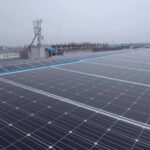How Quickly Can Solar Panels Pay for Themselves? Payback Period Explained
How Quickly Can Solar Panels Pay for Themselves? Payback Period Explained
One of the first questions people ask before going solar is: “How long will it take to recover my investment?” This is where the payback period comes in. Simply put, the payback period is the time it takes for the money you save on electricity bills to equal the total cost of your solar panel system.
In India, due to the rising electricity tariffs and government subsidies, the payback period has become shorter than ever. Whether you are a homeowner or running a commercial & industrial (C&I) setup, solar energy today offers a very attractive return on investment (ROI).
In this blog, we’ll break down the concept of the solar payback period, compare household and C&I installations, and explain why solar is a smart financial move in 2025.
What is the Payback Period in Solar?
The payback period refers to the time taken to recover the upfront investment in solar panels through savings on electricity bills. For example, if you spend ₹3 lakh on a solar system and save ₹60,000 annually on electricity, your payback period will be around 5 years.
Key factors that influence the payback period include:
- System size (kW capacity)
- Installation cost
- Electricity tariff in your state
- Government subsidies or incentives
- Usage patterns (daytime vs nighttime consumption)
Once the payback period is over, the electricity generated is virtually free, apart from small maintenance costs. Considering that solar panels last for 25 years or more, the returns after payback are huge.
Payback Period for Household Solar Installations
For residential rooftop systems, the payback period in India typically ranges between 3 and 6 years, depending on state tariffs and subsidies.
Why Household Solar Pays Back Faster:
- Government Subsidies: Under the PM Surya Ghar: Muft Bijli Yojana, households can get up to ₹78,000 subsidy for rooftop solar systems, reducing the initial cost.
- High Tariffs for Homes: Domestic electricity slabs often cross ₹7-₹9 per unit, so switching to solar results in higher savings per kWh.
- Smaller System Sizes: Solar panels for home usually include 3kW-5kW systems, making them affordable and quicker to pay back.
Example: A 5kW system costing around ₹3 lakh (after subsidy) can save ₹50,000-₹60,000 annually in electricity bills. This gives a payback period of around 5 years, after which the household enjoys 20+ years of free power.
Payback Period for C&I Solar Installations
For commercial and industrial setups, the payback period is even shorter, usually 2.5 to 4 years. Reasons why solar offers faster ROI are –
Higher Power Consumption
Businesses often face huge monthly bills at industrial tariffs ranging from ₹8 to ₹12 per unit. Solar offsets a large chunk of this.
No Subsidy, But Tax Benefits
While C&I setups don’t get direct subsidies, they can avail Accelerated Depreciation (AD) benefits and tax savings, reducing the effective payback period.
Larger Systems, Lower Cost per kW
Bigger projects (100kW+) benefit from economies of scale, lowering per-unit installation costs.
Example: A 100kW solar plant costing around ₹45–50 lakh can save ₹12-15 lakh annually in electricity costs. That means a payback period of just 3 years.
Factors That Influence Payback Period
The payback period is not the same everywhere; it depends on a combination of factors:
State Tariffs
States like Maharashtra, Tamil Nadu, and Haryana with high tariffs see faster payback compared to states with lower tariffs.
Subsidies
Residential users benefit from central subsidies; commercial setups gain through tax incentives.
System Quality
High-efficiency panels and good inverters may cost more initially but reduce payback by generating more electricity.
Net Metering Policies
States with clear net metering policies allow excess solar power to be exported, increasing savings.
Financing Options
Loans from SIDBI, PSUs, or NBFCs can spread out the cost, making payback more attractive.
While most people focus only on payback, the bigger picture is the lifetime savings from solar. A system with a 4-5 year payback can generate 20+ years of free electricity, saving households lakhs and businesses crores.
Other benefits include:
- Energy Independence: Reduced reliance on grid power.
- Protection from Rising Tariffs: Once installed, solar protects against future electricity price hikes.
- Sustainability: Solar reduces carbon emissions, supporting India’s renewable energy goals.
Why Smart Roof Solar is Your Best Partner
The payback period for solar panels in India has become shorter than ever, making it one of the smartest investments for both homes and businesses. With government subsidies, tax benefits, and rising grid tariffs, you can expect to recover your costs in just 3-5 years.
At Smart Roof Solar, we specialize in designing customized solar solutions that maximize savings and reduce payback time. From site surveys to installation and approvals, we handle everything, so you can start saving faster.
FAQs
Q1. How long is the average payback period for home solar in India?
Ans: Around 3-6 years, depending on system size, tariff, and subsidy.
Q2. Do commercial and industrial setups get subsidies?
Ans: No, but they get tax benefits and accelerated depreciation that reduce effective payback.
Q3. Can financing options affect the payback period?
Ans: Yes, loans may extend payback slightly, but make solar more affordable upfront.
Q4. What happens after the payback period ends?
Ans: You enjoy free electricity for 20+ years with only minimal maintenance costs.
Q5. Is the payback period the same in every state?
Ans: No, it depends on local tariffs, policies, and subsidies in each state.
Suggested Articles

Stop Losing Power: The Ultimate Guide to Solar DC & AC Cable Sizing for Max Efficiency
DC and AC cabling are the lifelines of any Solar PV Rooftop System. Learn how proper cable selection, connection design, and installation can help achieve optimum power output and long-term safety.
Breakthrough in Solar Technology: 33.2% Efficient Perovskite-Silicon Cell
Scientists achieve a breakthrough in solar technology with a perovskite-silicon tandem cell reaching a record 33.2% efficiency for higher energy output.

Solar Farm Development: Overcoming the Rising Challenge of Wiring Costs
Wiring costs are soaring in solar farms, affecting project budgets and timelines. Learn why infrastructure is becoming a key challenge.

Case Study: Successful Design, Installation, and Commissioning of a 50 kWp Rooftop Solar PV Plant
This case study details our experience in designing, installing, and commissioning a 50 kWp solar PV rooftop power plant. Learn how we overcame technical challenges, optimized system performance, and delivered clean, reliable energy. Discover insights on panel selection, inverter sizing, monitoring, and commissioning processes that ensured maximum efficiency and long-term performance for the rooftop solar installation.

Solar Rooftop: अपने घर को बनाओ खुद का पावर हाउस | Complete Guide
सौर रूफटॉप सिस्टम आपके घर को पावर हाउस बना सकता है। यह न केवल बिजली के बिलों में बचत करता है, बल्कि साफ और नवीकरणीय ऊर्जा भी प्रदान करता है। जानें सौर पैनल की इंस्टालेशन प्रक्रिया, लागत, लाभ और कैसे यह आपके घर को आत्मनिर्भर ऊर्जा का स्रोत बना सकता है।

Eco-Friendly Solar Panels: The Future of Sustainable Power
Eco-friendly solar panels are revolutionizing the way we generate clean energy. This blog explores their benefits, sustainable materials, and role in reducing carbon footprint while providing efficient energy solutions for residential, industrial, and commercial use. Learn why investing in eco-friendly solar technology is the future of sustainable power.

Solar Inverters India: How to Choose the Best for Your Solar System
India’s solar market offers a wide range of inverters, making selection challenging. This guide explains key factors to consider, helping users choose the right inverter for residential, commercial, and industrial solar projects effectively.

Solar Microgrids: All you need to know
Discover how solar batteries store excess energy, maximize your solar system’s efficiency, and provide reliable power during outages. Learn about the types, benefits, lifespan, and maintenance tips to make the most of your solar investment.